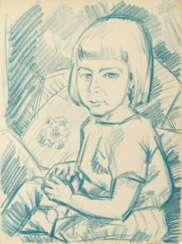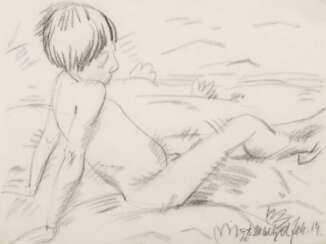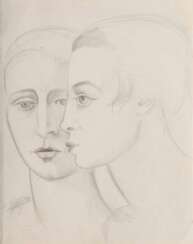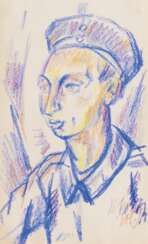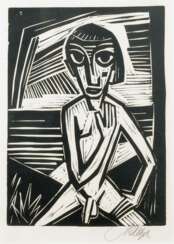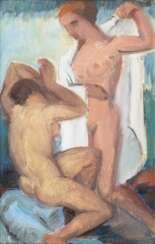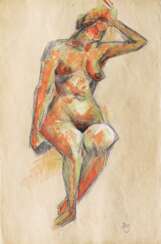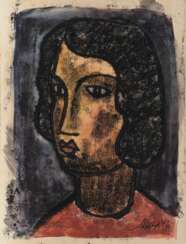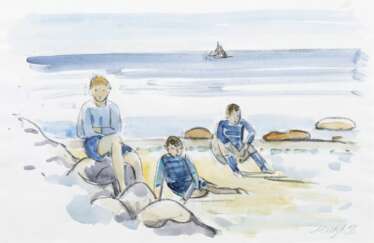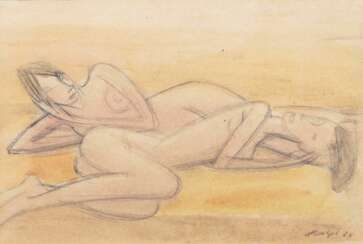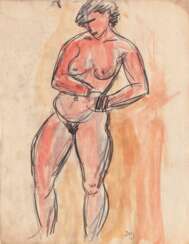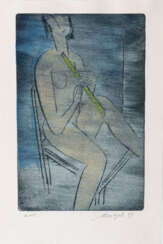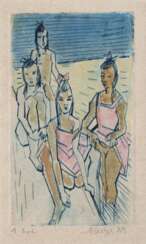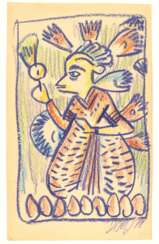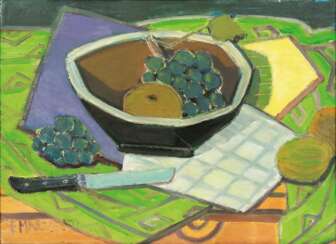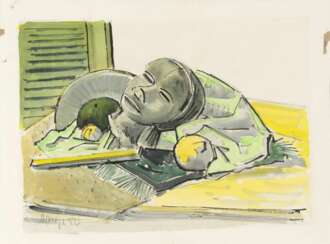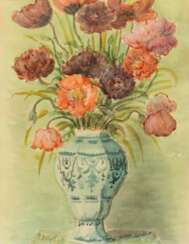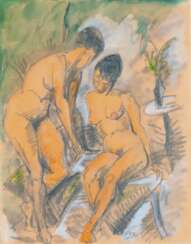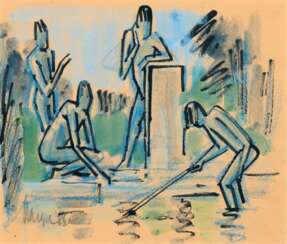maetzel
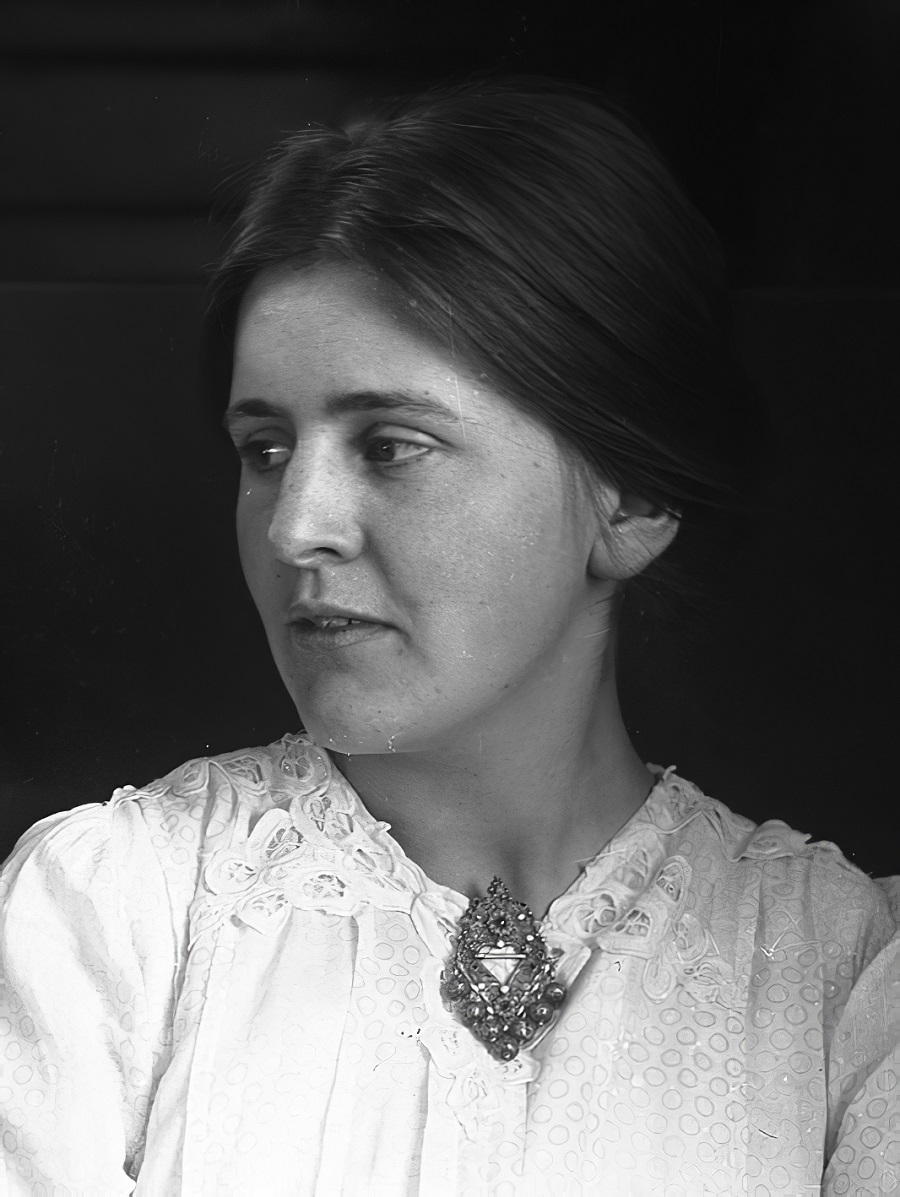
Dorothea Maetzel-Johannsen was a German modernist painter. She was a co-founder of the Hamburg Secession. Since 1919 she based her major expressionist works on the work of the dissolved Brücke (group of artists), early cubism and African sculpture.
Dorothea Maetzel-Johannsen has developed an individual mode of expression in Expressionism. Although her works feature the typical angular contours, two-dimensional concept of space and dynamic oblique compositions, unlike her peers, the artist refrained from any form of aggressiveness in her compositions. In her still life and figurative paintings, a contemplative mood resonates, contrary to the dynamic composition of the painting.
In 1937, Dorothea Maetzel-Johannsen's works were confiscated from the Kunsthalle Hamburg as part of the Nazi action "Degenerate Art" and then destroyed.


Dorothea Maetzel-Johannsen was a German modernist painter. She was a co-founder of the Hamburg Secession. Since 1919 she based her major expressionist works on the work of the dissolved Brücke (group of artists), early cubism and African sculpture.
Dorothea Maetzel-Johannsen has developed an individual mode of expression in Expressionism. Although her works feature the typical angular contours, two-dimensional concept of space and dynamic oblique compositions, unlike her peers, the artist refrained from any form of aggressiveness in her compositions. In her still life and figurative paintings, a contemplative mood resonates, contrary to the dynamic composition of the painting.
In 1937, Dorothea Maetzel-Johannsen's works were confiscated from the Kunsthalle Hamburg as part of the Nazi action "Degenerate Art" and then destroyed.
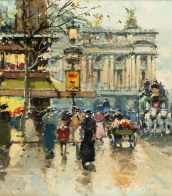

Dorothea Maetzel-Johannsen was a German modernist painter. She was a co-founder of the Hamburg Secession. Since 1919 she based her major expressionist works on the work of the dissolved Brücke (group of artists), early cubism and African sculpture.
Dorothea Maetzel-Johannsen has developed an individual mode of expression in Expressionism. Although her works feature the typical angular contours, two-dimensional concept of space and dynamic oblique compositions, unlike her peers, the artist refrained from any form of aggressiveness in her compositions. In her still life and figurative paintings, a contemplative mood resonates, contrary to the dynamic composition of the painting.
In 1937, Dorothea Maetzel-Johannsen's works were confiscated from the Kunsthalle Hamburg as part of the Nazi action "Degenerate Art" and then destroyed.
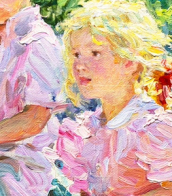

Dorothea Maetzel-Johannsen was a German modernist painter. She was a co-founder of the Hamburg Secession. Since 1919 she based her major expressionist works on the work of the dissolved Brücke (group of artists), early cubism and African sculpture.
Dorothea Maetzel-Johannsen has developed an individual mode of expression in Expressionism. Although her works feature the typical angular contours, two-dimensional concept of space and dynamic oblique compositions, unlike her peers, the artist refrained from any form of aggressiveness in her compositions. In her still life and figurative paintings, a contemplative mood resonates, contrary to the dynamic composition of the painting.
In 1937, Dorothea Maetzel-Johannsen's works were confiscated from the Kunsthalle Hamburg as part of the Nazi action "Degenerate Art" and then destroyed.


Dorothea Maetzel-Johannsen was a German modernist painter. She was a co-founder of the Hamburg Secession. Since 1919 she based her major expressionist works on the work of the dissolved Brücke (group of artists), early cubism and African sculpture.
Dorothea Maetzel-Johannsen has developed an individual mode of expression in Expressionism. Although her works feature the typical angular contours, two-dimensional concept of space and dynamic oblique compositions, unlike her peers, the artist refrained from any form of aggressiveness in her compositions. In her still life and figurative paintings, a contemplative mood resonates, contrary to the dynamic composition of the painting.
In 1937, Dorothea Maetzel-Johannsen's works were confiscated from the Kunsthalle Hamburg as part of the Nazi action "Degenerate Art" and then destroyed.

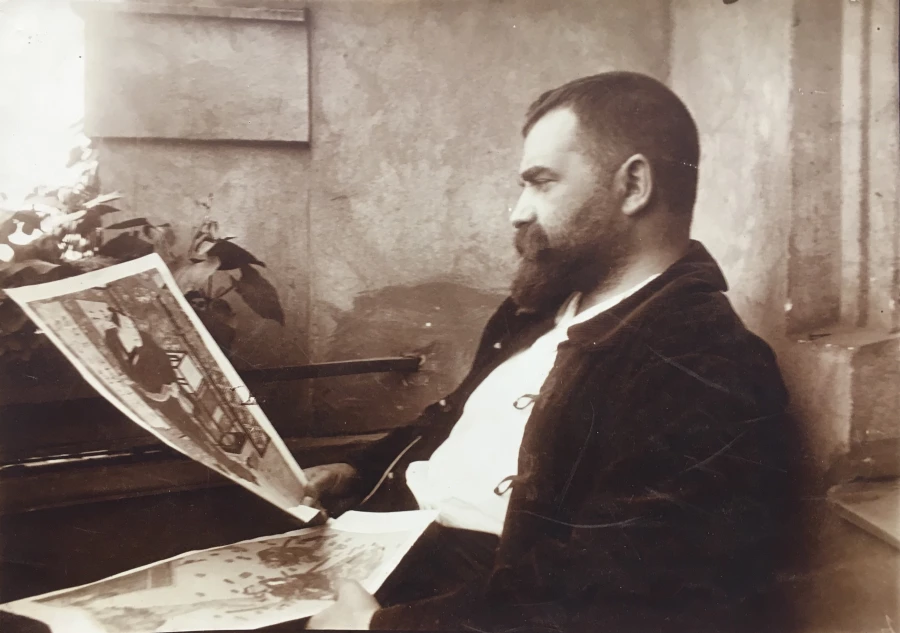
Emil Maetzel was a German architect, painter, graphic artist and sculptor.
In 1919, Maetzel was a co-founder of the Hamburg Secession, an organisation promoting modern art in northern Germany. He was also a member of the November Group, an association of expressionist artists in Berlin.


Dorothea Maetzel-Johannsen was a German modernist painter. She was a co-founder of the Hamburg Secession. Since 1919 she based her major expressionist works on the work of the dissolved Brücke (group of artists), early cubism and African sculpture.
Dorothea Maetzel-Johannsen has developed an individual mode of expression in Expressionism. Although her works feature the typical angular contours, two-dimensional concept of space and dynamic oblique compositions, unlike her peers, the artist refrained from any form of aggressiveness in her compositions. In her still life and figurative paintings, a contemplative mood resonates, contrary to the dynamic composition of the painting.
In 1937, Dorothea Maetzel-Johannsen's works were confiscated from the Kunsthalle Hamburg as part of the Nazi action "Degenerate Art" and then destroyed.
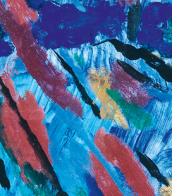

Dorothea Maetzel-Johannsen was a German modernist painter. She was a co-founder of the Hamburg Secession. Since 1919 she based her major expressionist works on the work of the dissolved Brücke (group of artists), early cubism and African sculpture.
Dorothea Maetzel-Johannsen has developed an individual mode of expression in Expressionism. Although her works feature the typical angular contours, two-dimensional concept of space and dynamic oblique compositions, unlike her peers, the artist refrained from any form of aggressiveness in her compositions. In her still life and figurative paintings, a contemplative mood resonates, contrary to the dynamic composition of the painting.
In 1937, Dorothea Maetzel-Johannsen's works were confiscated from the Kunsthalle Hamburg as part of the Nazi action "Degenerate Art" and then destroyed.


Dorothea Maetzel-Johannsen was a German modernist painter. She was a co-founder of the Hamburg Secession. Since 1919 she based her major expressionist works on the work of the dissolved Brücke (group of artists), early cubism and African sculpture.
Dorothea Maetzel-Johannsen has developed an individual mode of expression in Expressionism. Although her works feature the typical angular contours, two-dimensional concept of space and dynamic oblique compositions, unlike her peers, the artist refrained from any form of aggressiveness in her compositions. In her still life and figurative paintings, a contemplative mood resonates, contrary to the dynamic composition of the painting.
In 1937, Dorothea Maetzel-Johannsen's works were confiscated from the Kunsthalle Hamburg as part of the Nazi action "Degenerate Art" and then destroyed.


Dorothea Maetzel-Johannsen was a German modernist painter. She was a co-founder of the Hamburg Secession. Since 1919 she based her major expressionist works on the work of the dissolved Brücke (group of artists), early cubism and African sculpture.
Dorothea Maetzel-Johannsen has developed an individual mode of expression in Expressionism. Although her works feature the typical angular contours, two-dimensional concept of space and dynamic oblique compositions, unlike her peers, the artist refrained from any form of aggressiveness in her compositions. In her still life and figurative paintings, a contemplative mood resonates, contrary to the dynamic composition of the painting.
In 1937, Dorothea Maetzel-Johannsen's works were confiscated from the Kunsthalle Hamburg as part of the Nazi action "Degenerate Art" and then destroyed.


Dorothea Maetzel-Johannsen was a German modernist painter. She was a co-founder of the Hamburg Secession. Since 1919 she based her major expressionist works on the work of the dissolved Brücke (group of artists), early cubism and African sculpture.
Dorothea Maetzel-Johannsen has developed an individual mode of expression in Expressionism. Although her works feature the typical angular contours, two-dimensional concept of space and dynamic oblique compositions, unlike her peers, the artist refrained from any form of aggressiveness in her compositions. In her still life and figurative paintings, a contemplative mood resonates, contrary to the dynamic composition of the painting.
In 1937, Dorothea Maetzel-Johannsen's works were confiscated from the Kunsthalle Hamburg as part of the Nazi action "Degenerate Art" and then destroyed.


Dorothea Maetzel-Johannsen was a German modernist painter. She was a co-founder of the Hamburg Secession. Since 1919 she based her major expressionist works on the work of the dissolved Brücke (group of artists), early cubism and African sculpture.
Dorothea Maetzel-Johannsen has developed an individual mode of expression in Expressionism. Although her works feature the typical angular contours, two-dimensional concept of space and dynamic oblique compositions, unlike her peers, the artist refrained from any form of aggressiveness in her compositions. In her still life and figurative paintings, a contemplative mood resonates, contrary to the dynamic composition of the painting.
In 1937, Dorothea Maetzel-Johannsen's works were confiscated from the Kunsthalle Hamburg as part of the Nazi action "Degenerate Art" and then destroyed.


Dorothea Maetzel-Johannsen was a German modernist painter. She was a co-founder of the Hamburg Secession. Since 1919 she based her major expressionist works on the work of the dissolved Brücke (group of artists), early cubism and African sculpture.
Dorothea Maetzel-Johannsen has developed an individual mode of expression in Expressionism. Although her works feature the typical angular contours, two-dimensional concept of space and dynamic oblique compositions, unlike her peers, the artist refrained from any form of aggressiveness in her compositions. In her still life and figurative paintings, a contemplative mood resonates, contrary to the dynamic composition of the painting.
In 1937, Dorothea Maetzel-Johannsen's works were confiscated from the Kunsthalle Hamburg as part of the Nazi action "Degenerate Art" and then destroyed.


Emil Maetzel was a German architect, painter, graphic artist and sculptor.
In 1919, Maetzel was a co-founder of the Hamburg Secession, an organisation promoting modern art in northern Germany. He was also a member of the November Group, an association of expressionist artists in Berlin.


Emil Maetzel was a German architect, painter, graphic artist and sculptor.
In 1919, Maetzel was a co-founder of the Hamburg Secession, an organisation promoting modern art in northern Germany. He was also a member of the November Group, an association of expressionist artists in Berlin.


Emil Maetzel was a German architect, painter, graphic artist and sculptor.
In 1919, Maetzel was a co-founder of the Hamburg Secession, an organisation promoting modern art in northern Germany. He was also a member of the November Group, an association of expressionist artists in Berlin.


Emil Maetzel was a German architect, painter, graphic artist and sculptor.
In 1919, Maetzel was a co-founder of the Hamburg Secession, an organisation promoting modern art in northern Germany. He was also a member of the November Group, an association of expressionist artists in Berlin.


Emil Maetzel was a German architect, painter, graphic artist and sculptor.
In 1919, Maetzel was a co-founder of the Hamburg Secession, an organisation promoting modern art in northern Germany. He was also a member of the November Group, an association of expressionist artists in Berlin.


Emil Maetzel was a German architect, painter, graphic artist and sculptor.
In 1919, Maetzel was a co-founder of the Hamburg Secession, an organisation promoting modern art in northern Germany. He was also a member of the November Group, an association of expressionist artists in Berlin.


Dorothea Maetzel-Johannsen was a German modernist painter. She was a co-founder of the Hamburg Secession. Since 1919 she based her major expressionist works on the work of the dissolved Brücke (group of artists), early cubism and African sculpture.
Dorothea Maetzel-Johannsen has developed an individual mode of expression in Expressionism. Although her works feature the typical angular contours, two-dimensional concept of space and dynamic oblique compositions, unlike her peers, the artist refrained from any form of aggressiveness in her compositions. In her still life and figurative paintings, a contemplative mood resonates, contrary to the dynamic composition of the painting.
In 1937, Dorothea Maetzel-Johannsen's works were confiscated from the Kunsthalle Hamburg as part of the Nazi action "Degenerate Art" and then destroyed.


Dorothea Maetzel-Johannsen was a German modernist painter. She was a co-founder of the Hamburg Secession. Since 1919 she based her major expressionist works on the work of the dissolved Brücke (group of artists), early cubism and African sculpture.
Dorothea Maetzel-Johannsen has developed an individual mode of expression in Expressionism. Although her works feature the typical angular contours, two-dimensional concept of space and dynamic oblique compositions, unlike her peers, the artist refrained from any form of aggressiveness in her compositions. In her still life and figurative paintings, a contemplative mood resonates, contrary to the dynamic composition of the painting.
In 1937, Dorothea Maetzel-Johannsen's works were confiscated from the Kunsthalle Hamburg as part of the Nazi action "Degenerate Art" and then destroyed.


Emil Maetzel was a German architect, painter, graphic artist and sculptor.
In 1919, Maetzel was a co-founder of the Hamburg Secession, an organisation promoting modern art in northern Germany. He was also a member of the November Group, an association of expressionist artists in Berlin.


Emil Maetzel was a German architect, painter, graphic artist and sculptor.
In 1919, Maetzel was a co-founder of the Hamburg Secession, an organisation promoting modern art in northern Germany. He was also a member of the November Group, an association of expressionist artists in Berlin.


Dorothea Maetzel-Johannsen was a German modernist painter. She was a co-founder of the Hamburg Secession. Since 1919 she based her major expressionist works on the work of the dissolved Brücke (group of artists), early cubism and African sculpture.
Dorothea Maetzel-Johannsen has developed an individual mode of expression in Expressionism. Although her works feature the typical angular contours, two-dimensional concept of space and dynamic oblique compositions, unlike her peers, the artist refrained from any form of aggressiveness in her compositions. In her still life and figurative paintings, a contemplative mood resonates, contrary to the dynamic composition of the painting.
In 1937, Dorothea Maetzel-Johannsen's works were confiscated from the Kunsthalle Hamburg as part of the Nazi action "Degenerate Art" and then destroyed.


Emil Maetzel was a German architect, painter, graphic artist and sculptor.
In 1919, Maetzel was a co-founder of the Hamburg Secession, an organisation promoting modern art in northern Germany. He was also a member of the November Group, an association of expressionist artists in Berlin.


Emil Maetzel was a German architect, painter, graphic artist and sculptor.
In 1919, Maetzel was a co-founder of the Hamburg Secession, an organisation promoting modern art in northern Germany. He was also a member of the November Group, an association of expressionist artists in Berlin.


Emil Maetzel was a German architect, painter, graphic artist and sculptor.
In 1919, Maetzel was a co-founder of the Hamburg Secession, an organisation promoting modern art in northern Germany. He was also a member of the November Group, an association of expressionist artists in Berlin.


Dorothea Maetzel-Johannsen was a German modernist painter. She was a co-founder of the Hamburg Secession. Since 1919 she based her major expressionist works on the work of the dissolved Brücke (group of artists), early cubism and African sculpture.
Dorothea Maetzel-Johannsen has developed an individual mode of expression in Expressionism. Although her works feature the typical angular contours, two-dimensional concept of space and dynamic oblique compositions, unlike her peers, the artist refrained from any form of aggressiveness in her compositions. In her still life and figurative paintings, a contemplative mood resonates, contrary to the dynamic composition of the painting.
In 1937, Dorothea Maetzel-Johannsen's works were confiscated from the Kunsthalle Hamburg as part of the Nazi action "Degenerate Art" and then destroyed.


Dorothea Maetzel-Johannsen was a German modernist painter. She was a co-founder of the Hamburg Secession. Since 1919 she based her major expressionist works on the work of the dissolved Brücke (group of artists), early cubism and African sculpture.
Dorothea Maetzel-Johannsen has developed an individual mode of expression in Expressionism. Although her works feature the typical angular contours, two-dimensional concept of space and dynamic oblique compositions, unlike her peers, the artist refrained from any form of aggressiveness in her compositions. In her still life and figurative paintings, a contemplative mood resonates, contrary to the dynamic composition of the painting.
In 1937, Dorothea Maetzel-Johannsen's works were confiscated from the Kunsthalle Hamburg as part of the Nazi action "Degenerate Art" and then destroyed.


Emil Maetzel was a German architect, painter, graphic artist and sculptor.
In 1919, Maetzel was a co-founder of the Hamburg Secession, an organisation promoting modern art in northern Germany. He was also a member of the November Group, an association of expressionist artists in Berlin.

